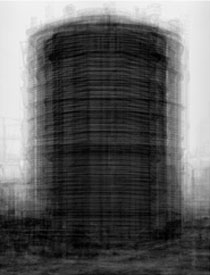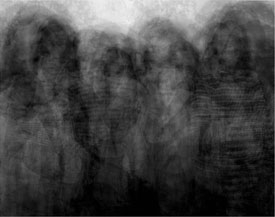Feature: Reviews
Idris Khan
- Fraenkel Gallery
- San Francisco
- May 4 - June 30, 2006
“What is this?” was my first response to Idris Khan’s exhibition at Fraenkel Gallery.
There is a photograph of a postcard of a Turner painting that might be a pastel, a photograph of a Nicholas Nixon photograph that might be a charcoal drawing, a photograph of a Beethoven score that might be a Terry Winters painting or a scroll of calligraphy thick with ink, a photograph of a Bernd and Hilla Becher photograph that might be an etching. Beyond that, the women in Khan’s Nixon photograph, the Becher gas tank, and the musical score can barely be made out. There is a photograph of an open book whose text is seductive but unreadable, and lastly, a photograph that is mostly a field of dots on a silvery ground. What, indeed, is this? Are these photographs? What are photographs? And what do they signify?
This is a small show—seven photographs — with a big impact and large implications. It is the first exhibition in the United States of the young British photographer, Idris Khan, who has been extensively recognized in England.
Khan appropriates, enlarges and reinterprets in personal ways, iconic objective photographic images by Nicholas Nixon, Bernd and Hilla Becher and scientist Karl Blossfeldt. He also photographs and much enlarges close-up views of objects of personal significance — the dense late scores of a near-deaf Beethoven, a book by media philosopher and Holocaust survivor Vilem Flusser on the meaning of photographic images, a book of close-up plant photographs.
The major pieces at Fraenkel are large. They are mounted on aluminum and framed in brushed aluminum. Framed, they are 8’ high. The photographs I will be discussing are all lambda C prints. This means that Khan photographs black and white photographs in color, layers his negatives and scans them through a computer, printing them in black and white and in large scale. In this way, he appropriates iconic objective photographic images by Nicholas Nixon and Bernd and Hilla Becher, interpreting them in personal ways to create a new photograph.
In every…Nicholas Nixon’s Brown Sisters (2004) Khan appropriated Nixon’s annual photographs of his wife and three sisters, layering them to create an entirely new photograph. Nixon’s photographs of the Brown sisters are detailed psychological portraits of both the individual women and of their interaction. The narrative takes place over twenty years. Khan’s photograph is not a portrait of individuals. He has layered so many photographs that the result is an almost indistinguishable brownish grey field in which some planes and cubist fragments appear. Mostly, what emerges are a few faces with haunting eyes. Is this Khan’s portrait of the way we see brown women as indistinguishable, unknown and frightening shadows? Or is it a portrait of women’s hidden, cloaked condition in Muslim societies?
In every…Bernd and Hilla Becher Prison Type Gasholder (2004) Khan photographed the Becher image many times with a 4 x 5 camera. Instead of the Bechers’ sharp, detailed image of this industrial form, Khan’s photograph portrays an object with no definite outline. His photograph shows a large, indefinite architectural object merging with its background to create an allover, fluctuating field of lines. As a result, perhaps it might seem contradictorily, Khan’s photograph has more dimensionality and volume than the Becher’s defined form in a flattened photographic space. Scaled up to 8’, Khan’s image has a looming quality which is also, especially up close, psychologically ominous, perhaps recalling to mind a Piranesi etching.
In Blossfeldt…After Karl Blossfeldt ‘Art Forms in Nature’, (2005), Khan has appropriated the photographs of Karl Blossfeldt, a scientist who encyclopedically photographed greatly enlarged close-ups of plant forms. Blossfeldt’s close-up photographs transform these small sections of sometimes tiny plants into monumental sculptural shapes. By photographing Blossfeldt’s photographs through a fine screen to create a half-tone and scaling up his photograph to 8’, layering his negatives, scanning them in a computer, Khan breaks down Blossfeldt’s discrete volumetric forms into an allover half-tone field in which the figure and ground merge. Khan’s photograph, Blossfeldt…After Karl Blossfeldt ‘Art Forms in Nature’ is an abstract allover metallic field in which layered plant shapes float. Appropriately enough, the subject of the picture is a layering of a multitude of detailed photographs of small archetypal shapes taken from nature. The aluminum mount and brushed aluminum frame give a metallic sheen to this photographic cosmic web.
Khan also photographs iconic music scores and books of importance to him. He has photographed Chopin piano sonatas, a long horizontal photograph corresponding visually to Chopin’s long melodic lines. At Fraenkel, Struggling to Hear…After Ludwig van Beethoven Sonatas (2005) Khan has photographed the pages of Beethoven’s piano sonatas and using the same techniques of layering, scanning and printing in black and white and large scale, arrived at a photograph that is sculptural, painterly and alludes to Chinese calligraphy.
The photograph is 8’ high with stacked, dense black bars corresponding to the dense chordal harmonies of Beethoven’s music. Within and around the black bars, hidden within and escaping from them, are musical notes and markings. Khan has added to the blacks creating a thick, gestural almost painterly surface. What would Beethoven’s sonatas sound like if they were played all at once? This photograph is perhaps a visual equivalent of that John Cage-like layered music — dense, dark, buoyant, heavy, large and dimensional.
The one square photograph at Fraenkel is a monumental photograph of an open book. Vilem Flusser’s Toward a Philosophy of Photography is a tiny book measuring 8x10” when open. Khan’s photograph is about 4’ square. The book is photographed in extreme close-up. Khan photographed each page and layered the negatives. As a result, the central fold has become a deep black column and the pages have become sculptural, almost like the two scrolls of a Torah. However, the lines of text, seeming at first to be out of focus, float out of the photographic frame, layered and illegible.
We trust photographs to tell us the truth, from the portraits of Nadar portraits to the documentation of August Sanders, Eugene Atget, Bernice Abbot, Carleton Watkins, and Walker Evans, to the more ambiguous contemporary work of Stephen Shore and Henry Wessel. Beginning with impressionism and cubism, painting questioned what and how we see. With these photographs, Idris Khan brings the doubt of phenomena and our perception of images to photography. As Vilem Flusser writes, the act of photography is one of “phenomenological doubt.”


